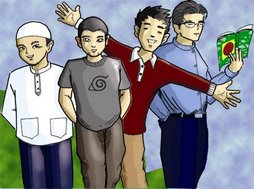HANOI, Vietnam - Luong Van Inh is among a neglected group of Asians threatened by an environmental hazard rarely considered: indoor air pollution. Caused by burning wood, coal or other cheap fuels in kitchens, it kills about 1.5 million people worldwide each year.
Inh's wheezing gasps and the gritty soot covering his tiny kitchen are testament to the damage caused from decades of cooking over a wood fire with no chimney to draw out the billowing smoke. He has lived in the stilt house in the impoverished northern mountain town of Dien Bien Phu since birth.
"I have had asthma since I was young, but the problem has been getting worse," said Inh, 70, who shuns cigarettes but has hovered over the kitchen stove preparing meals for his family since his wife died 25 years ago. "When it rains and it's humid, I find it hard to breathe if I cook."
Up to 3 billion people around the world rely on solid fuels such as wood, coal, crop waste or animal dung for indoor cooking and heating. The resulting smoke ranks as the fourth-biggest health risk in the poorest countries, yet it is typically overlooked.
The Lancet medical journal highlighted the problem this week in a series on energy and health. One article stressed that improved stoves with chimneys could reduce exposure to indoor smoke by 30 percent to 50 percent.
"Most people would not be able to imagine what it's like to live in a smoky hut," said Eva Rehfuess, of the World Health Organization's Partnership for Clean Indoor Air. "It's 10 times worse than the most polluted cities."
She said even WHO was surprised by the magnitude of the problem. It was first addressed in the 2002 World Health Report, that ranked it after water and sanitation as one of the biggest environmental health risks in the developing world.
Earlier this year, the WHO for the first time estimated the effects of indoor air pollution on health within individual countries. In 2002, nearly two-thirds of all global deaths linked to burning solid fuels were in the Asia-Pacific region.
Afghanistan, Pakistan and Bangladesh had the highest percentage of death and disease linked to indoor air pollution in Asia, followed by India and Laos. Combined, more than half a million deaths occur annually in those countries alone.
Women and children are the hardest-hit because they are at home the most. Mothers in many developing countries cook with their babies strapped to their backs, exposing their infant lungs to the smoke.
Indoor air pollution has received scant attention even though it kills up to 800,000 children each year, mainly from pneumonia. The smoke has been linked to everything from lung cancer to cataracts and respiratory diseases.
"This affects only the poorest, so it's easy for the decision makers who no longer live in this type of community to not even see it," said John J. Mitchell, of the U.S. Environmental Protection Agency's Partnership for Clean Indoor Air. He attended a household air pollution workshop in Hanoi last month.
Pollution levels recorded in some Bangladesh and Indian kitchens were up to 40 times higher than the WHO's recommended levels over a 24-hour period. During peak cooking times, those rates spiked even more.
Using improved stoves and cleaner fuels are the best way to attack the problem, but cost remains a barrier.
China started the world's largest stove modernizing effort in the 1980s, handing out up to 180 million new units, all with chimneys, over 15 years. The driving force was not health, but fuel efficiency, as farmers were running out of cooking fuel by the end of the year.
Kirk Smith, a leading expert on indoor air pollution from the University of California, Berkeley, said better stoves reduce smoke but don't eliminate it.
"In the longer run, you need to move to cleaner fuel, and there are prospects for making cleaner fuel" out of local resources, said Smith, a co-author of one of the Lancet papers.
Several countries are converting animal and farm waste into clean-burning biogas. Smith said new technology is also available to prevent stoves from polluting, but it also is out of reach for the poor.
"In one sense you might say the problem is poverty," he said. "By the time everyone was able to afford cleaner fuel, you'd be talking another 50 or 100 years."
___
Associated Press reporter Vu Tien Hong contributed to this report from Dien Bien Phu, Vietnam
Langgan:
Catat Ulasan (Atom)






Tiada ulasan:
Catat Ulasan